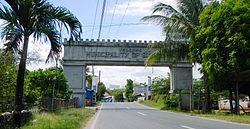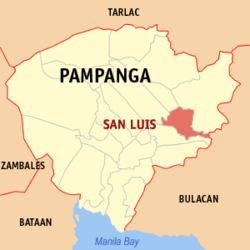San Luis, Pampanga
San Luis | |
|---|---|
| Municipality of San Luis | |
 Welcome Arc | |
 Map of Pampanga with San Luis highlighted | |
 | |
Location within the Philippines | |
| Coordinates: 15°02′24″N 120°47′31″E / 15.04°N 120.7919°E | |
| Country | |
| Region | Central Luzon |
| Province | Pampanga |
| District | 4th District |
| Founded | 1761 |
| Barangays | 17 (see Barangays) |
| Government | |
| • Type | Sangguniang Bayan |
| • Mayor | Jayson S. Sagum |
| • Vice Mayor | Roman A. Sagum |
| • Congressman | Juan Pablo P. Bondoc |
| • Electorate | 36,761 voters (2022) |
| Area | |
| • Total | 56.83 km2 (21.94 sq mi) |
| Elevation | 8.0 m (26.2 ft) |
| Population (2020 census)[3] | |
| • Total | 58,551 |
| • Density | 1,000/km2 (2,700/sq mi) |
| • Households | 12,836 |
| Economy | |
| • Income class | 3rd municipal income class |
| • Poverty incidence | 9.61% (2015)[4] |
| • Revenue (₱) | ₱ 170.8 million (2020) |
| • Assets (₱) | ₱ 488.4 million (2020) |
| • Liabilities (₱) | ₱ 150.3 million (2020) |
| • Expenditure (₱) | ₱ 130 million (2020) |
| Time zone | UTC+8 (PST) |
| ZIP code | 2014 |
| PSGC | |
| IDD : area code | +63 (0)45 |
| Native languages | Kapampangan Tagalog |
San Luis, officially the Municipality of San Luis, is a 3rd class municipality in the province of Pampanga, Philippines. According to the 2020 census, it had a population of 58,551 people.[3]
Barangays
San Luis is politically subdivided into 17 barangays. Like the town itself, all political subdivisions are named after Roman Catholic saints.
- San Agustin
- San Carlos
- San Isidro
- San Jose
- San Juan
- San Nicolas
- San Roque
- San Sebastian
- Santa Catalina
- Santa Cruz Pambilog
- Santa Cruz Poblacion
- Santa Lucia
- Santa Monica
- Santa Rita
- Santo Niño
- Santo Rosario
- Santo Tomas
Climate
| Climate data for San Luis, Pampanga | |||||||||||||
|---|---|---|---|---|---|---|---|---|---|---|---|---|---|
| Month | Jan | Feb | Mar | Apr | May | Jun | Jul | Aug | Sep | Oct | Nov | Dec | Year |
| Mean daily maximum °C (°F) | 28 (82) |
29 (84) |
31 (88) |
33 (91) |
32 (90) |
31 (88) |
30 (86) |
29 (84) |
29 (84) |
30 (86) |
30 (86) |
28 (82) |
30 (86) |
| Mean daily minimum °C (°F) | 20 (68) |
20 (68) |
21 (70) |
23 (73) |
24 (75) |
24 (75) |
24 (75) |
24 (75) |
24 (75) |
23 (73) |
22 (72) |
21 (70) |
23 (72) |
| Average precipitation mm (inches) | 6 (0.2) |
4 (0.2) |
6 (0.2) |
17 (0.7) |
82 (3.2) |
122 (4.8) |
151 (5.9) |
123 (4.8) |
124 (4.9) |
99 (3.9) |
37 (1.5) |
21 (0.8) |
792 (31.1) |
| Average rainy days | 3.3 | 2.5 | 3.6 | 6.6 | 17.7 | 22.2 | 25.2 | 23.7 | 23.2 | 17.9 | 9.2 | 5.2 | 160.3 |
| Source: Meteoblue [5] | |||||||||||||
Demographics
|
| ||||||||||||||||||||||||||||||||||||||||||||||||
| Source: Philippine Statistics Authority[6][7][8][9] | |||||||||||||||||||||||||||||||||||||||||||||||||
In the 2020 census, the population of San Luis, Pampanga, was 58,551 people,[3] with a density of 1,000 inhabitants per square kilometre or 2,600 inhabitants per square mile.
Like other municipalities and cities in Pampanga, its people are mostly Kapampangan.
Religion
Roman Catholicism remains the faith of the majority in San Luis. Other christian religions, such as, Iglesia ni Cristo, United Methodist Church, Members Church of God International, Evangelicals, Ang Iglesia Metodista sa Pilipinas, Baptists, and Born Again Christianity can be found in the Municipality.
Economy
Transportation, trade and commerce in San Luis is concentrated at the town center where the public market, cockpit, municipal hall, church, schools, hospital, clinics, and commercial spaces are situated.
Local government
The municipal government is divided into three branches: executive, legislative and judiciary. The judicial branch is administered solely by the Supreme Court of the Philippines. The executive branch is composed of the mayor and the barangay captains for the barangays. The legislative branch is composed of the Sangguniang Bayan (town assembly), Sangguniang Barangay (barangay council), and the Sangguniang Kabataan for the youth sector.
The current mayor of San Luis, Dr. Jayson S. Sagum or also known as Dr. J, and the vice mayor is Mon A. Sagum
Landmarks

St. Aloysius Gonzaga Church
Its façade can compare immeasurably with existing Spanish-style church edifices and architectural design. The church is located in a place that used to be called Cabagsac, referring to the proliferation of fruit bats. In fact, today, a fishnet is permanently installed high above the altar precisely to catch thousands of bats that are roosting inside the church. The interior is dark, has an ambience of antiquity and mystery and overpowering odor of bat urine. The main attraction is the three-tower facade, perhaps one of its kind in the country. Not to be missed is the ancient cemetery located in a hidden corner at the back of the church, with some tombstones dating back to the 1800s and bearing the names of the town's prominent families, including the Elizaldes, Ablazos, Francos, Tarucs, among others.[10]
Education
There is a prime school in the town aside from public elementary and high schools.
Notable people
- Luis Taruc (June 21, 1913 - May 4, 2005), founder and leader of Hukbalahap, was born of peasant folks in the farming town of San Luis, Pampanga.
Images
-
Rice Field in San Jose, San Luis
-
Downtown San Luis
-
Municipal Hall of San Luis
-
Public market
-
District Hospital
References
- ^ Municipality of San Luis | (DILG)
- ^ "Province: Pampanga". PSGC Interactive. Quezon City, Philippines: Philippine Statistics Authority. Retrieved 12 November 2016.
- ^ a b c Census of Population (2020). "Region III (Central Luzon)". Total Population by Province, City, Municipality and Barangay. Philippine Statistics Authority. Retrieved 8 July 2021.
- ^ "PSA releases the 2015 Municipal and City Level Poverty Estimates". Quezon City, Philippines. Retrieved 1 January 2020.
- ^ "San Luis: Average Temperatures and Rainfall". Meteoblue. Retrieved 5 May 2020.
- ^ Census of Population (2015). "Region III (Central Luzon)". Total Population by Province, City, Municipality and Barangay. Philippine Statistics Authority. Retrieved 20 June 2016.
- ^ Census of Population and Housing (2010). "Region III (Central Luzon)" (PDF). Total Population by Province, City, Municipality and Barangay. National Statistics Office. Retrieved 29 June 2016.
- ^ Censuses of Population (1903–2007). "Region III (Central Luzon)". Table 1. Population Enumerated in Various Censuses by Province/Highly Urbanized City: 1903 to 2007. National Statistics Office.
{{cite encyclopedia}}: CS1 maint: numeric names: authors list (link) - ^ "Province of Pampanga". Municipality Population Data. Local Water Utilities Administration Research Division. Retrieved 17 December 2016.
- ^ "WOW Philippines :: Explore Philippines :: Things to Do". Retrieved 2008-04-25. Note: Things to Do and see in Pampanga...







